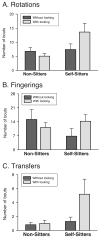Systems in development: motor skill acquisition facilitates three-dimensional object completion
- PMID: 20053012
- PMCID: PMC2805173
- DOI: 10.1037/a0014618
Systems in development: motor skill acquisition facilitates three-dimensional object completion
Abstract
How do infants learn to perceive the backs of objects that they see only from a limited viewpoint? Infants' 3-dimensional object completion abilities emerge in conjunction with developing motor skills--independent sitting and visual-manual exploration. Infants at 4.5 to 7.5 months of age (n = 28) were habituated to a limited-view object and tested with volumetrically complete and incomplete (hollow) versions of the same object. Parents reported infants' sitting experience, and infants' visual-manual exploration of objects was observed in a structured play session. Infants' self-sitting experience and visual-manual exploratory skills predicted looking at the novel, incomplete object on the habituation task. Further analyses revealed that self-sitting facilitated infants' visual inspection of objects while they manipulated them. The results are framed within a developmental systems approach, wherein infants' sitting skill, multimodal object exploration, and object knowledge are linked in developmental time.
Copyright 2009 APA, all rights reserved.
Figures




Similar articles
-
Sitting skill and the emergence of arms-free sitting affects the frequency of object looking and exploration.Dev Psychobiol. 2019 Nov;61(7):1035-1047. doi: 10.1002/dev.21854. Epub 2019 Apr 22. Dev Psychobiol. 2019. PMID: 31012090
-
Training of 7-month-old infants' manual object exploration skills: Effects of active and observational experience.Infant Behav Dev. 2019 Nov;57:101353. doi: 10.1016/j.infbeh.2019.101353. Epub 2019 Sep 6. Infant Behav Dev. 2019. PMID: 31499397
-
Object exploration during the transition to sitting: A study of infants at heightened risk for autism spectrum disorder.Infancy. 2020 Sep;25(5):640-657. doi: 10.1111/infa.12341. Epub 2020 Jun 10. Infancy. 2020. PMID: 32857443 Free PMC article.
-
The ecology of infants' perceptual-motor exploration.Curr Opin Psychol. 2020 Apr;32:110-114. doi: 10.1016/j.copsyc.2019.06.035. Epub 2019 Jul 26. Curr Opin Psychol. 2020. PMID: 31445428 Review.
-
Motor Development: Embodied, Embedded, Enculturated, and Enabling.Annu Rev Psychol. 2019 Jan 4;70:141-164. doi: 10.1146/annurev-psych-010418-102836. Epub 2018 Sep 26. Annu Rev Psychol. 2019. PMID: 30256718 Free PMC article. Review.
Cited by
-
Infants plan prehension while pivoting.Dev Psychobiol. 2019 Nov;61(7):1048-1063. doi: 10.1002/dev.21856. Epub 2019 Apr 29. Dev Psychobiol. 2019. PMID: 31032892 Free PMC article.
-
It's all connected: Pathways in visual object recognition and early noun learning.Am Psychol. 2013 Nov;68(8):618-29. doi: 10.1037/a0034185. Am Psychol. 2013. PMID: 24320634 Free PMC article.
-
Developmental process emerges from extended brain-body-behavior networks.Trends Cogn Sci. 2014 Aug;18(8):395-403. doi: 10.1016/j.tics.2014.04.010. Epub 2014 May 24. Trends Cogn Sci. 2014. PMID: 24862251 Free PMC article.
-
Visual-motor coordination in natural reaching of young children and adults.Cogsci. 2015 Jul;2015:728-733. Cogsci. 2015. PMID: 29226279 Free PMC article.
-
Developmentally Changing Attractor Dynamics of Manual Actions with Objects in Late Infancy.Complexity. 2018;2018:4714612. doi: 10.1155/2018/4714612. Epub 2018 Nov 1. Complexity. 2018. PMID: 33597794 Free PMC article.
References
-
- Adolph KE. Learning to keep balance. In: Kail R, editor. Advances in child development and behavior. Vol. 30. Amsterdam: Elsevier Science; 2002. pp. 1–40. - PubMed
-
- Adolph KE, Badaly D, Garciaguirre JS, Sotsky R. 15,000 steps: Infants’ locomotor experience. 2008. Manuscript in preparation.
-
- Adolph KE, Eppler MA, Marin L, Weise IB, Clearfield MW. Exploration in the service of prospective control. Infant Behavior & Development. 2000;23:441–460.
-
- Arterberry ME, Yonas A. Infants’ sensitivity to kinetic information for three-dimensional object shape. Perception & Psychophysics. 1988;44:1–6. - PubMed
-
- Arterberry ME, Yonas A. Perception of three-dimensional shape specified by optic flow by 8-week-old infants. Perception & Psychophysics. 2000;62:550–556. - PubMed

